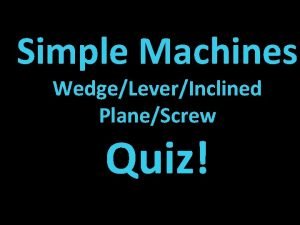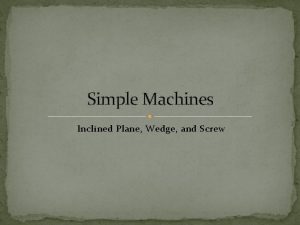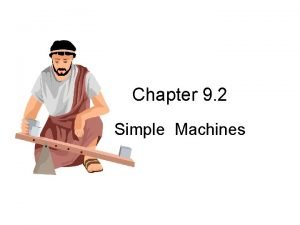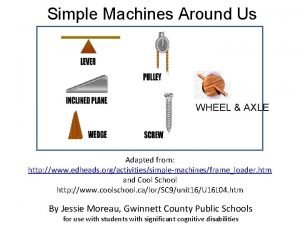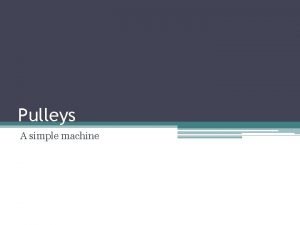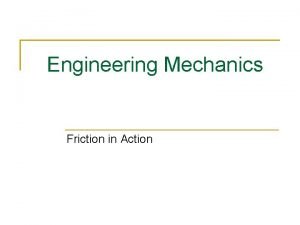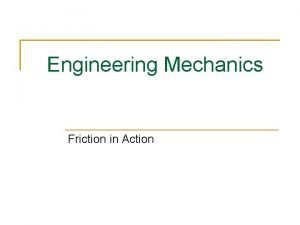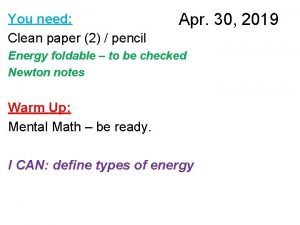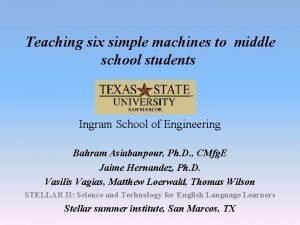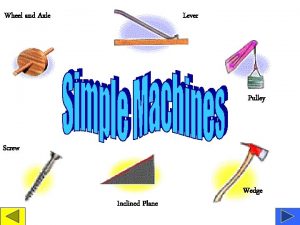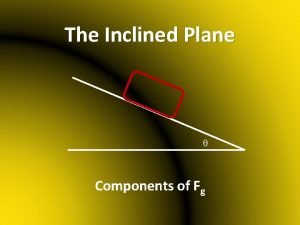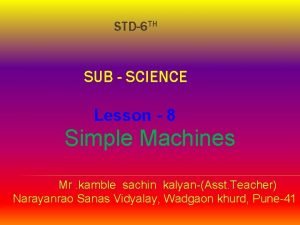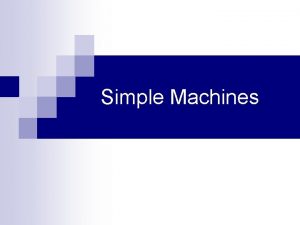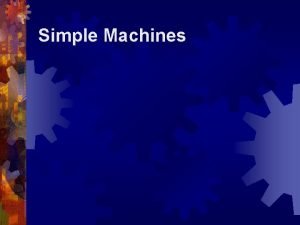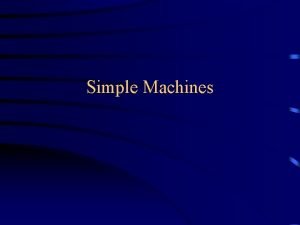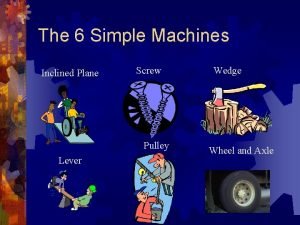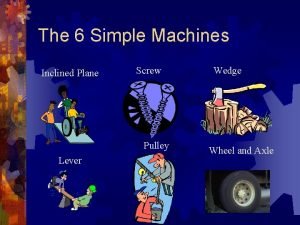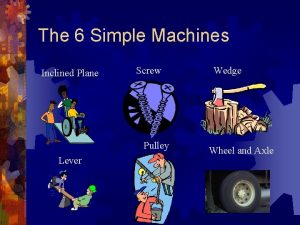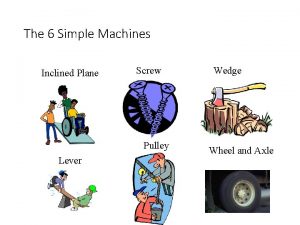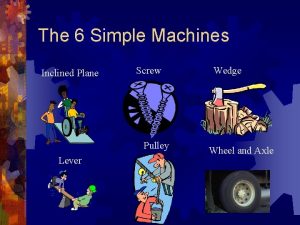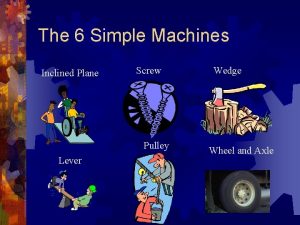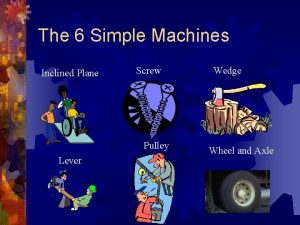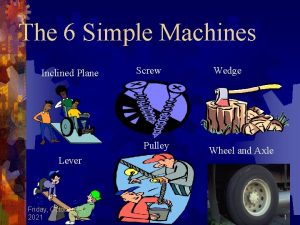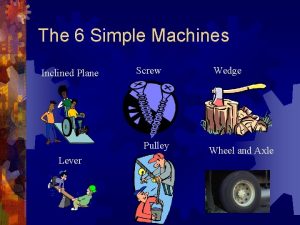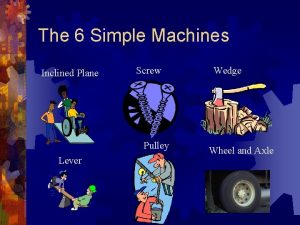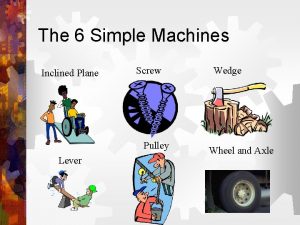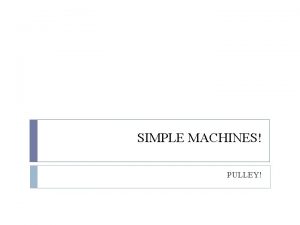The 6 Simple Machines Inclined Plane Screw Pulley




















- Slides: 20

The 6 Simple Machines Inclined Plane Screw Pulley Lever Wedge Wheel and Axle

Definitions: Energy: Ability to do work Work Force x Distance = Force: A Push or a Pull

Inclined Plane

Inclined Plane ® The Egyptians used simple machines to build the pyramids. One method was to build a very long incline out of dirt that rose upward to the top of the pyramid very gently. The blocks of stone were placed on large logs (another type of simple machine - the wheel and axle) and pushed slowly up the long, gentle inclined plane to the top of the pyramid.

Inclined Planes ® An inclined plane is a flat surface that is higher on one end ® Inclined planes make the work of moving things easier

Work input and output ® Work input is the amount of work done on a machine. ® Input force x input distance ® Work output is the amount of work done by a machine. ® Output force x output distance Wout = Win Fout x Dout = Fin x Din Dout 3 m 10 N x 3 m = 2 N x 15 m 10 N Din 15 m Fin

Screw The screw is using to hold things together or hold things in place

Wedges ® Two inclined planes joined back to back. ® Wedges are used to split things.

First Class Lever Fulcrum is between EF (effort) and RF (load)

First Class Lever. ® Common examples of first-class levers include crowbars, scissors, pliers, tin snips and seesaws.

Second Class Lever RF (load) is between fulcrum and EF Effort moves farther than Resistance. Multiplies EF, but does not change its direction

Second Class Lever ® Examples of second-class levers include nut crackers, wheel barrows, doors, and bottle openers.

Third Class Lever EF is between fulcrum and RF (load) Does not multiply force Resistance moves farther than Effort. Multiplies the distance the effort force travels

Third Class Lever ® Examples of third-class levers include tweezers, arm hammers, and shovels.

Pulleys ® Pulley are wheels and axles with a groove around the outside ® A pulley needs a rope, chain or belt around the groove to make it do work

Diagrams of Pulleys Fixed pulley: Movable Pulley: A fixed pulley changes the direction of a force; however, it does not create a mechanical advantage. The mechanical advantage of a moveable pulley is equal to the number of ropes that support the moveable pulley.

COMBINED PULLEY ® The effort needed to lift the load is less than half the weight of the load. ® The main disadvantage is it travels a very long distance.

WHEEL AND AXEL ® The axle is stuck rigidly to a large wheel. Fan blades are attached to the wheel. When the axel turns, the fan blades spin.

GEARS-Wheel and Axel ® Each gear in a series reverses the direction of rotation of the previous gear. The smaller gear will always turn faster than the larger gear.

Rube Goldberg Machines Rube Goldberg machines are examples of complex machines. ® All complex machines are made up of combinations of simple machines. ® Rube Goldberg machines are usually a complicated combination of simple machines. ® By studying the components of Rube Goldberg machines, we learn more about simple machines ®
 Planescrew
Planescrew Screw inclined plane
Screw inclined plane Ima of wedge
Ima of wedge Simple machine window blinds
Simple machine window blinds Simple machines examples
Simple machines examples What is a wedge in simple machines
What is a wedge in simple machines Wheel and axle examples around the house
Wheel and axle examples around the house Uses of a pulley
Uses of a pulley A flat belt connects pulley a to pulley b
A flat belt connects pulley a to pulley b A flat belt connects pulley a to pulley b
A flat belt connects pulley a to pulley b Pulley and screw
Pulley and screw Software-defined networking: a comprehensive survey
Software-defined networking: a comprehensive survey Inclined plane simple machine
Inclined plane simple machine Http://www.mikids.com/smachines.htm
Http://www.mikids.com/smachines.htm Curved inclined plane
Curved inclined plane Simple machines history
Simple machines history Inclined plane and lever
Inclined plane and lever Inclined plate clarifier
Inclined plate clarifier Along inclined plane wrapped around a shaft
Along inclined plane wrapped around a shaft An inclined plane wrapped around a post
An inclined plane wrapped around a post Is a bicycle a compound machine
Is a bicycle a compound machine
